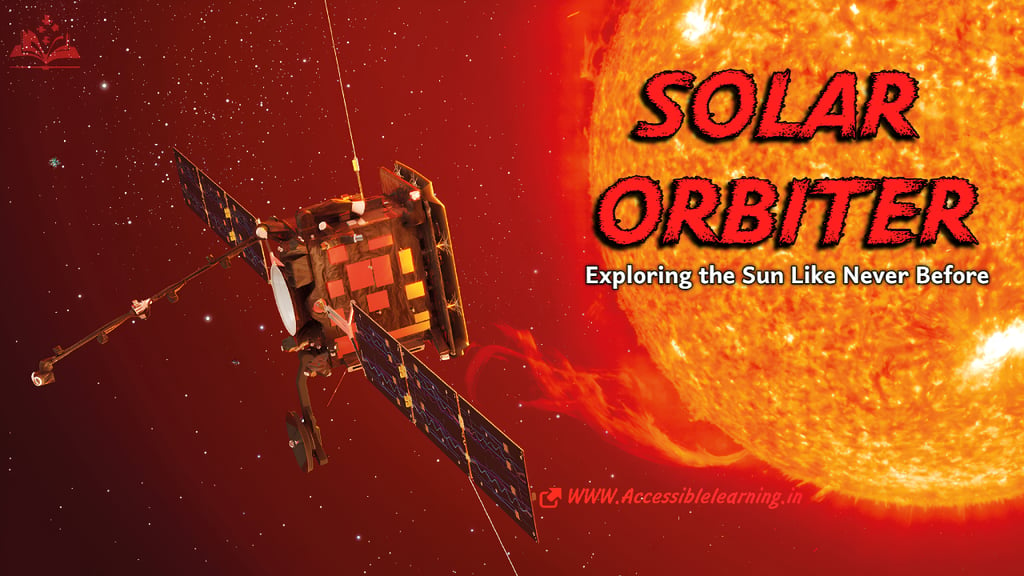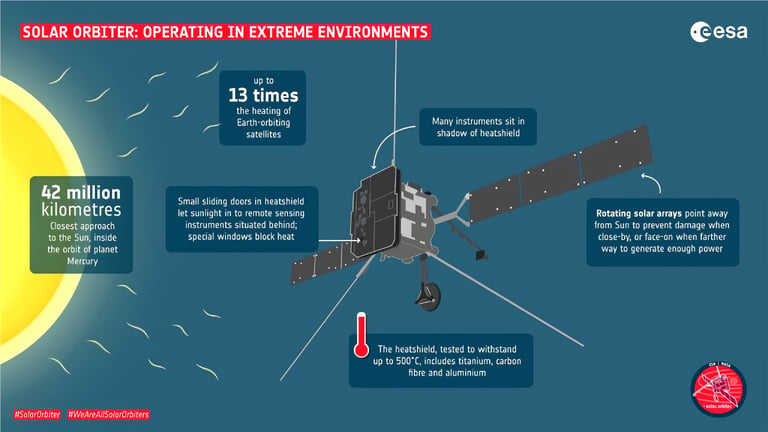
Solar Orbiter: Exploring the Sun Like Never Before
Discover the Solar Orbiter, a groundbreaking mission by ESA and NASA designed to unveil the Sun's mysteries. Learn about its cutting-edge instruments, major discoveries, and future milestones as it provides unprecedented insights into solar activity, space weather, and the Sun’s impact on the solar system.
ISRO/NASASPACE MISSIONEDUCATION/KNOWLEDGESPACE/TECH
Sachin K Chaurasiya
3/23/20255 min read


The Solar Orbiter, a collaborative mission between the European Space Agency (ESA) and NASA, is one of the most ambitious space probes ever designed to study the Sun. Launched on February 10, 2020, from Cape Canaveral, Florida, this cutting-edge spacecraft is providing unprecedented insights into our closest star. By capturing high-resolution images and collecting critical data, the Solar Orbiter aims to answer some of the most fundamental questions about the Sun's behavior and its impact on the solar system.
Objectives of the Solar Orbiter Mission
The Solar Orbiter is designed to study the Sun up close, particularly focusing on:
The Sun's Polar Regions: One of the most unique aspects of the mission is its ability to observe the Sun’s poles, which were previously difficult to study.
Solar Wind and Space Weather: Understanding the solar wind and its impact on Earth's magnetosphere.
Magnetic Field and Solar Flares: Studying how the Sun's magnetic field leads to solar flares and coronal mass ejections (CMEs).
Inner Heliosphere Dynamics: Investigating how energy and particles move through the heliosphere—the Sun’s extended atmosphere.
Solar Cycle Variations: Tracking changes in the Sun's activity across its 11-year solar cycle, helping predict space weather effects.
Origins of Solar Storms: Identifying the source regions of solar storms and their potential impact on Earth and satellites.
Solar Dynamo Mechanism: Understanding how the Sun’s magnetic field is generated and maintained over time.
Cutting-Edge Technology on Board
The Solar Orbiter is packed with advanced instruments, which allow it to capture groundbreaking data. Some of its key scientific tools include:
Remote Sensing Instruments (Imaging the Sun)
PHI (Polarimetric and Helioseismic Imager): Captures detailed images of the Sun’s magnetic field and measures oscillations on the solar surface.
EUI (Extreme Ultraviolet Imager): Monitors the Sun’s atmosphere in high-energy ultraviolet light, crucial for studying coronal heating.
SPICE (Spectral Imaging of the Coronal Environment): Analyzes the Sun’s outer layers by detecting specific wavelengths and temperature gradients.
SoloHI (Solar Orbiter Heliospheric Imager): Observes the solar wind and interplanetary dust, tracking solar ejections.
STIX (Spectrometer/Telescope for Imaging X-rays): Detects X-ray emissions from solar flares, providing insights into energy release mechanisms and particle acceleration.
In-Situ Instruments (Measuring the Sun’s Environment)
MAG (Magnetometer): Measures fluctuations in the Sun’s magnetic field, capturing rapid changes associated with solar activity.
SWA (Solar Wind Analyzer): Analyzes the charged particles streaming from the Sun and their composition, speed, and density.
EPD (Energetic Particle Detector): Detects high-energy particles that can impact satellites and astronauts, helping assess space weather risks.
RPW (Radio and Plasma Waves): Studies how the Sun interacts with space through radio wave emissions and helps detect plasma instabilities.
DPU (Data Processing Unit): Manages data collection and transmission to Earth, optimizing the spacecraft’s efficiency.


Major Discoveries So Far
Since its launch, Solar Orbiter has already made significant discoveries:
First-ever close-up images of 'Campfires': These are miniature solar flares found on the Sun’s surface, which could explain the mystery of the coronal heating problem.
Detailed views of solar poles: These will help scientists understand how the solar cycle works and how the Sun’s magnetic field evolves.
Understanding solar wind acceleration: The probe has revealed new insights into how charged particles escape the Sun’s atmosphere and travel across the solar system.
Magnetic Field Reversals: Observations suggest that the Sun’s magnetic field undergoes small-scale, temporary reversals that could play a role in shaping space weather.
Unprecedented views of coronal mass ejections (CMEs): Providing more details about how solar storms originate and evolve over time.
Identification of Alfven Waves: These waves are crucial in energy transport within the Sun’s corona and could play a role in coronal heating.
How Solar Orbiter Differs from Other Sun Missions
While other missions like NASA’s Parker Solar Probe are studying the Sun’s corona by flying extremely close, the Solar Orbiter’s unique elliptical orbit allows it to observe the Sun from different angles, including the poles. This is crucial for understanding long-term solar activity, such as the 11-year solar cycle.
Unlike Parker Solar Probe, which mainly focuses on measuring plasma and solar wind properties, Solar Orbiter’s suite of imaging and remote sensing instruments allows it to visualize solar phenomena in great detail, complementing Parker’s data. Additionally, Solar Orbiter operates at a greater distance, allowing it to avoid extreme heating and enabling longer observational campaigns.
Future of the Mission
The Solar Orbiter is expected to continue its observations until at least 2030. As it gradually gets closer to the Sun (within 42 million km at its closest approach), it will provide even more high-resolution images and data, helping scientists unravel the deepest mysteries of our star.
Upcoming Milestones
First close pass near the Sun's equator (2025): Will help refine solar cycle predictions.
Observations of extreme solar storms (2026-2027): Crucial for understanding space weather impacts on Earth.
Final phase of the mission (2030+): Expected to deliver the most detailed insights yet into the Sun’s inner workings.
Polar orbit phase (2027+): Expected to provide unprecedented high-latitude observations, aiding in understanding the solar magnetic field’s evolution.
Why the Solar Orbiter Mission Matters
The Sun is the engine of life on Earth, but it can also pose serious risks. Understanding how solar storms and radiation affect Earth’s technology, satellites, and astronauts is essential. The Solar Orbiter's data will help scientists predict space weather events, improve satellite design, and even aid in planning for future Mars missions, where astronauts will need better protection from solar radiation.


FAQs
What is the purpose of the Solar Orbiter mission?
The Solar Orbiter is designed to study the Sun’s poles, magnetic field, solar wind, and space weather to help scientists understand how the Sun affects the solar system, including Earth.
How is the Solar Orbiter different from the Parker Solar Probe?
While the Parker Solar Probe flies much closer to the Sun, the Solar Orbiter captures high-resolution images and studies the Sun’s poles, providing unique insights into the solar cycle.
How close does the Solar Orbiter get to the Sun?
At its closest approach, the Solar Orbiter will come within 42 million km (26 million miles) of the Sun—closer than Mercury’s orbit.
What are the key discoveries made by the Solar Orbiter so far?
Some major discoveries include miniature solar flares (“campfires”), solar wind acceleration mechanisms, magnetic field reversals, and detailed coronal mass ejections (CMEs).
How long will the Solar Orbiter mission last?
The mission is planned to continue until at least 2030, with multiple flybys and close passes to gather critical solar data.
Why is studying the Sun important?
Understanding the Sun helps us predict space weather events, protect satellites and power grids, and prepare for future space missions where astronauts could be affected by solar radiation.
The Solar Orbiter is revolutionizing solar science by offering a new perspective on the Sun’s complex behavior. Its groundbreaking discoveries are not just shaping our understanding of the Sun but also helping us prepare for space weather events that can impact satellites, power grids, and astronauts. With its advanced instruments and daring trajectory, the Solar Orbiter is set to change the way we see the Sun—one discovery at a time.
As the mission progresses, we can expect even more astonishing revelations that could reshape our knowledge of the solar system and beyond.
Subscribe To Our Newsletter
All © Copyright reserved by Accessible-Learning Hub
| Terms & Conditions
Knowledge is power. Learn with Us. 📚


